Where flavour comes alive
Ready for a tropical and adventure, with notes of vanilla, custard, citrus, orchard and stone fruits, mango and pineapple? Sweet, Fruity & Mellow is the flavour profile for you. Julien Willems delves into where these enticing aromas come from and what leads the Society’s Tasting Panel to place a single malt in this category.
All flavours in whisky come from the ingredients and the way they are processed. The malted barley and the yeast are at the origin of flavour creation, particularly during fermentation. But equally important are the type of stills used, the cut points for distillation and the type of condensers.
And last, but far from least, there’s the wood treatment and how the cask itself introduces flavours during the maturation process. Many of the compounds resulting from these processes are flavour active, and the profile of each individual whisky is created by the relative contribution of each compound to the overall perceived flavour.
It’s About The Esters
So what about Sweet, Fruity & Mellow? A key family of compounds in this flavour profile are the esters, and there are a wide variety of these, typically associated with fruity and floral aromas. The variations in types of esters and their concentrations are endless, and as a result, so are the fruity impressions they can create. Different esters can be perceived as aromas of citrus fruits and green apples (isoamyl acetate, if you want to get chemical about it) for instance, others may trigger thoughts of banana, mango and overripe pineapple (that’ll be the ethyl butanoate at work).
Don’t Ignore The Yeast
Yeast activity during fermentation generates alcohol and a host of metabolic by-products, including esters, acids and aldehydes. It is in the washback where most of the flavours in whisky, other than those derived from the cask, are created. Distillers know how to accentuate the fruitiness of the spirit through control of fermentation.
For example, longer fermentation results in fruitier spirit, as the concentration of esters increases with time. Combine this with a clear wort from the mash tun, or opt for ‘high gravity’ brewing (essentially using more concentrated ‘wash’) and you can create even more esters and a fruitier spirit.
Still Science
Creating a clean fruity spirit is not just about getting fermentation right – the distillation process is of equal importance. Certain types of stills create higher reflux during distillation, concentrating lighter, more volatile molecules like the esters in the new-make spirit. As the concentration of progressively heavier, less volatile compounds that could mask fruity flavours rises in the still, a distiller may choose to stop the distillation to keep the spirit light and fruity (think the Society’s distillery 112 for a number of supercharged fruity examples).
Into The Wood
To become true whisky, a spirit needs a partner, and a carefully selected cask makes the perfect soulmate. Whiskies in this flavour profile derive their sweetness from compounds such as oak lactones and vanillin, which are extracted from the wood during maturation.
“American oaks have higher concentrations of lactones than French or Spanish oak and can bestow superb aromas of gorse and coconut to a whisky,” says Society spirits educator Dr Andy Forrester. (For a tasty example of a high lactone oak, give blended malt Batch #12 Clementine Confit a try.)
Heat treatment of the oak through toasting or charring during cooperage breaks down lignin, a structural component of wood. This releases a diverse range of sweet-tasting flavour compounds. Vanillin – which tastes and smells of what it says on the tin – is a significant contributor to sweetness in mature whisky.
And that’s not all. Fruitiness may also increase during maturation as slow chemical reactions take place, in which ethanol is ultimately converted into esters. All in all, compounds derived from fermentation, distillation and maturation account for the sweet and fruity elements of this profile.
A Mellow Fellow
What makes a whisky mellow then? Chemically, we’re not quite sure, but ‘harshness’ in a spirit may be linked to various factors, one of which is the ethanol itself.
Alcohol evaporates from the cask during maturation (faster than water when maturing in Scotland): this phenomenon, known as the ‘Angels’ Share’, means that over time the whisky in the cask loses strength. As Society whiskies are bottled at cask strength, this means that age may also be linked to how mellow the spirit is, with youthful whiskies typically being ‘sprightly’, and older whiskies softer and mellower.
We also know that in long fermentation, bacteria take over from the yeast. Their ‘malolactic’ fermentation doesn’t produce alcohol, but it does produce other important flavour compounds such as lactic acid, which is thought to give whisky a creamy and buttery character, and hence a perceived mellow temperament.
On paper, if you wanted to create an archetypical Sweet, Fruity & Mellow whisky you would use a clear wort, give it a long fermentation, take high cut points during distillation, then store the spirit in an active American oak cask. But even though distillery 135 has provided us with many great examples, there is no sure-fire method to achieve a single cask of this profile.
For ultimately, when it comes to creating a whisky of this style, it’s a matter of knowledge, skill and of course a bit of luck. Over time a balance and harmony of flavours from spirit and cask is reached. A partnership which, like so many things in life, turns out to be much more than the mere sum of its parts.
Discover & Experiment
Here are some flavour adventures we have suggested in recent years for whiskies in our Sweet, Fruity & Mellow flavour profile.
Matching dessert: Spiced mango and raspberry cheesecake
Matching main course: Tony Singh’s South Indian masala langoustines
In cocktails: Try Sweet, Fruity & Mellow in a Pink Highball Cocktail

